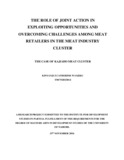| dc.description.abstract | This study sought to understand the persistence of challenges in the meat industry cluster despite the existence of joint action. This was based on the theoretical and empirical understanding that when firms and entrepreneurs in the same industry work together, in what is referred to as joint action, they can easily overcome their challenges and exploit external opportunities that present to the industry. For this study, joint action was defined as actively pursued collaboration among firms in the same industry to either respond to a crisis or take advantage of a new opportunity. The study had three objectives: to explain the ways through which joint action occurs among meat retailers in Kajiado, to assess the objective that joint action is trying to fulfil in the meat cluster in Kajiado and to suggest ways through which joint action can be enhanced in the Kajiado Meat Cluster.
The review of literature focused on the contextual understanding of what a cluster is and what joint action is. To this effect therefore, it was understood that a cluster is a concentration of firms in the same sector or industry located in a close geographical location. The literature review also focussed on the benefits of joint action to a cluster such as protection of common interests, representation when penetrating new markets or to government through collective bargaining powers, exchanging information and ideas among firms, providing joint technical knowledge and marketing among other benefits. Further, the literature review acknowledged that there are factors that may influence the ability of firms to work together such as unequal power relations and the cost of joint action.
The Study focused on the two retailing clusters of Kitengela and Isinya in Kajiado East Sub County. It interviewed two categories of retailers, that is those who owned butcheries and those who bought animals for slaughter then sold the animals. They were referred to as retailing agents. To achieve the stated objectives, both quantitative and qualitative techniques were used. The study interviewed 52 retailers out of a population of 102 retailers as per the records of the meat inspector. Primary data on joint action was supplemented with survey data from the retailers and key informant interviews with the County officials and chairpersons of some of the retailer associations.
The study established that all retailers in the cluster engaged in one form or the other of bilateral (involving only two actors) joint action, the decision of whom to corporate with, depended on how important the actor was to the survival of the enterprise and the trust build amongst the two actors. Multilateral joint action was however not as popular as bilateral joint action. The measure of engagement in multilateral joint action was membership to any group such as an association or Chama. The primary objective of joint action in most the groupings was to improve access to credit, although some such as the Kitengela retailer’s association existed to impose a code of conduct. However, other benefits often emerged because of being joint such as access to government training, improved rapport in the industry, exchange of knowledge and information, welfare gains where the groups acted as social safety net and lobbying for common interest such as improving infrastructure. Factors such as policy, retailer perceptions and cultural factors impacted the formation and success of joint action.
As the study sought to explain the persistence of challenges despite the existence of joint action, it emerged that the critical factors of scope, perception and awareness influenced the ability of joint action to surmount the challenges and exploit the opportunities. The scope of the existing joint action was limited and did not cover all the challenges in the industry, the retailers were not aware of external opportunities they could exploit or the fact that these opportunities could be exploited through joint action. To this effect, the study recommended continuous capacity building on the opportunities for growth and expansion of the industry through joint action. | en_US |



